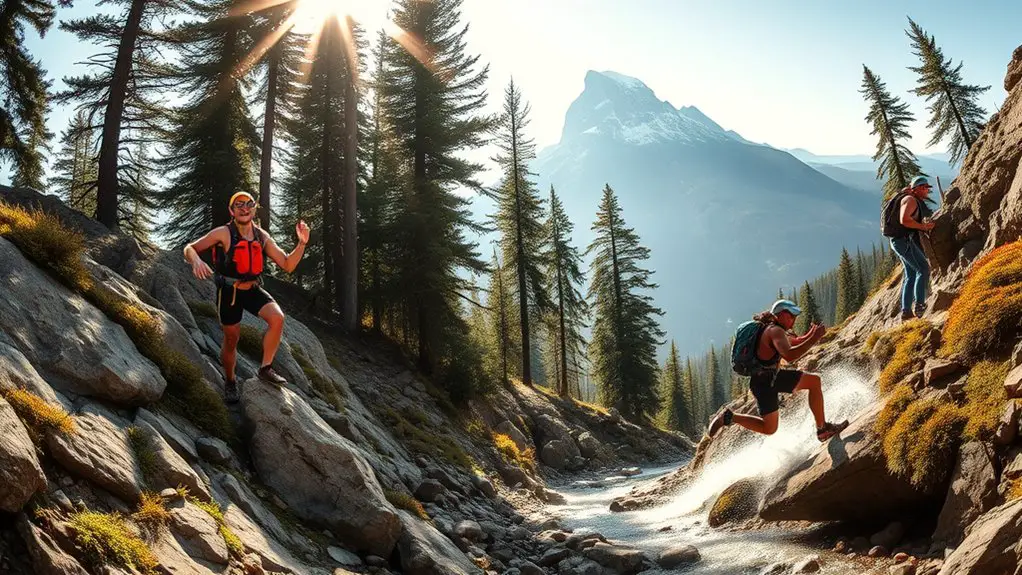To build stamina for long-distance hiking, start by evaluating your current fitness level and choose shorter, local trails that match your ability. Gradually increase your hike durations by 15 to 30 minutes each week. Incorporate strength training and interval workouts to boost endurance and power. Don't forget to prioritize nutrition and hydration to fuel your body. Set realistic goals and track your progress to stay motivated. There's plenty more to discover about enhancing your hiking experience.
Assess Your Current Fitness Level
Before you commence your journey to build stamina for hiking, it's crucial to assess your current fitness level. Take a moment to reflect on your physical capabilities. Can you comfortably walk a few miles without feeling wiped out? If so, you're off to a good start. Evaluate how often you engage in physical activities like walking, running, or cycling. Consider your flexibility, balance, and strength, too.
You don't need to be an athlete, but knowing where you stand will help you set realistic goals. If you struggle with short distances, don't worry; this is your chance to grow. Embrace the freedom that comes with knowing your body's limits. By understanding your fitness level, you can create a tailored plan that leads you toward longer hikes. Remember, every step forward is a step closer to the trails you dream of exploring. Incorporating high-intensity interval training can also be a game changer to boost your endurance efficiently.
Start With Shorter Hikes
When you're starting out, it's best to choose local trails that match your current fitness level. Focus on shorter hikes and gradually increase the distance as you build your stamina. Pay attention to the terrain too, as it can make a big difference in how challenging your hikes feel.
Choose Local Trails
Choosing local trails not only makes hiking more accessible, but it also allows you to start with shorter hikes that match your current fitness level. By exploring nearby paths, you'll be free to enjoy the outdoors without the stress of long travel times. Here are some benefits of choosing local trails:
- Familiarity: You know the area and can navigate easily.
- Flexibility: You can hike whenever you want, fitting it into your schedule.
- Community: Connect with locals who share your passion for nature.
- Safety: You're closer to help in case of emergencies.
- Conservation: Supporting local trails helps keep your community's natural spaces thriving.
Embrace the freedom of local hikes as you build your stamina!
Gradually Increase Distance
Starting with shorter hikes is essential for gradually increasing your distance and building stamina. You don't want to overwhelm yourself right away; instead, embrace the freedom of exploring local trails at your own pace. Begin with hikes that last an hour or two, allowing your body to adapt naturally. As you grow more comfortable, gradually extend your hikes by 15 to 30 minutes each week. This steady approach not only strengthens your legs and lungs but also boosts your confidence. Remember, it's all about enjoying the journey. Celebrate small milestones, and soon you'll find yourself ready to tackle longer adventures. With each step, you're not just building stamina; you're discovering the thrill of the great outdoors.
Focus on Terrain
As you build stamina for hiking, focusing on the terrain can make a significant difference in your experience and endurance. Start with shorter hikes that introduce you to various surfaces and inclines. This approach helps you adapt without overwhelming your body. Consider these key terrain types to explore:
- Flat trails for easy pacing and warm-ups.
- Gentle inclines to build strength gradually.
- Rocky paths to improve balance and agility.
- Mud or sand to challenge your footing and endurance.
- Steep climbs for a serious workout and to boost stamina.
Incorporate Strength Training
While many hikers focus solely on cardiovascular endurance, incorporating strength training into your routine can considerably enhance your stamina on the trails. Strength training builds muscle, which supports your joints and helps you carry your pack more comfortably. Plus, it increases your overall power, allowing you to tackle those steep ascents with ease. Additionally, exercises like squats and lunges can improve your balance and stability, making it easier to navigate uneven terrain.
You don't need to hit the gym for hours. Simple bodyweight exercises like squats, lunges, and push-ups can be done anywhere. You might also consider adding resistance bands or weights to challenge yourself further. Aim for two to three sessions a week, targeting your legs, core, and upper body.
Practice Interval Training
Interval training can boost your hiking stamina by alternating between high-intensity bursts and lower-intensity recovery periods. This method not only improves your cardiovascular fitness but also enhances your overall endurance. Additionally, incorporating high-intensity interval training into your routine can lead to increased metabolism and improved mental toughness. Let's explore some effective interval workouts you can incorporate into your routine.
Benefits of Interval Training
If you're looking to boost your stamina for hiking, incorporating interval training into your routine can be a game changer. This method alternates between high-intensity bursts and rest or low-intensity periods, making your workouts more effective and enjoyable. Here are some benefits of interval training:
- Increased endurance: You'll build stamina faster, allowing you to tackle longer trails.
- Time-efficient: Get a great workout in less time compared to steady-state cardio.
- Improved speed: You'll notice quicker paces on the trail, enhancing your overall hiking experience.
- Enhanced metabolism: Burn more calories even after your workout ends.
- Keeps it interesting: Break the monotony of your routine and stay motivated.
With these advantages, you'll find yourself ready for those breathtaking hikes in no time!
Sample Interval Workouts
To effectively practice interval training for hiking, you'll want to incorporate specific workouts that challenge your body and build your stamina. Start with hill repeats: find a steep incline and sprint up for 30 seconds, then walk back down for recovery. Repeat this 5-10 times. Next, try a tempo hike: maintain a brisk pace for 20 minutes, then slow down for 10 minutes to recover. Mix in longer hikes with short bursts of speed; every 5 minutes, pick up your pace for 1 minute. Finally, consider adding strength training with lunges and squats, focusing on your legs. These workouts will not only improve your stamina but also enhance your overall hiking experience, giving you the freedom to explore longer trails.
Prioritize Nutrition and Hydration
While you gear up for your hiking adventures, prioritizing nutrition and hydration is essential for building stamina. You want to fuel your body and keep it energized, especially on those long trails. Here are some key points to remember:
Prioritize nutrition and hydration to fuel your body and build stamina for those challenging hiking trails.
- Stay Hydrated: Drink water before, during, and after your hike.
- Balanced Meals: Include carbs, proteins, and healthy fats in your diet.
- Snacks on the Go: Pack energy-boosting snacks like nuts, fruits, or energy bars.
- Electrolytes Matter: Consider electrolyte drinks to replace lost minerals.
- Listen to Your Body: Eat and hydrate when you feel the need; don't wait until you're thirsty or hungry. Proper hydration helps avoid fatigue and cramps, allowing you to enjoy your hike fully.
Set Realistic Goals and Track Progress
Setting realistic goals and tracking your progress can greatly enhance your stamina-building journey for hiking. Start by identifying achievable milestones, whether it's hiking a specific distance or conquering a certain elevation. Break these larger goals into smaller steps; this way, you won't feel overwhelmed, and you'll celebrate victories along the way.
As you progress, keep a journal or use an app to log your hikes. Note the distances, times, and how you felt during each trek. This tracking not only helps you see how far you've come but also reveals patterns and areas for improvement.
Stay flexible with your goals; if you find a certain target is too ambitious, adjust it. The freedom to adapt your plans keeps the journey enjoyable and prevents burnout. Remember, every step you take brings you closer to your hiking dreams. Embrace the journey and let your progress fuel your passion for the outdoors. Additionally, use the SMART criteria to ensure your goals are well-defined and measurable for tracking your success.
Frequently Asked Questions
How Often Should I Hike to Build Stamina Effectively?
To build stamina effectively, you should hike at least three times a week. Consistency's key, so mix in longer hikes on weekends. You'll notice improvements in your endurance and overall enjoyment of the trails.
What Gear Is Essential for Long-Distance Hiking?
When you're planning a long-distance hike, essential gear includes a sturdy backpack, comfortable footwear, weather-appropriate clothing, water purification system, navigation tools, and first aid supplies. It'll keep you prepared for any adventure that comes your way.
Can Yoga Help Improve My Hiking Stamina?
Imagine flowing like a river through a forest; yoga can indeed enhance your stamina. It strengthens your core and improves flexibility, allowing you to roam freely across trails, embracing nature's beauty with every step.
How Do I Prevent Injuries While Training?
To prevent injuries while training, you've gotta listen to your body. Warm up properly, gradually increase intensity, and incorporate rest days. Staying flexible and strengthening your muscles will keep you moving freely and pain-free.
What Should I Do if I Feel Fatigued on a Hike?
If you feel fatigued on a hike, take a break, hydrate, and snack. Listen to your body; it's okay to slow down. Enjoy the moment and breathe in the freedom of nature around you.




